

Achieve Fluency in Verbal Communication

Get access to animated learning videos, interactive quizzes, projects and more — all on the Uolo Learn app!




Get access to animated learning videos, interactive quizzes, projects and more — all on the Uolo Learn app!
Achieve Fluency in Verbal Communication

Academic Authors: Sneha Sharma, Chandani Goyal, Ayushi Jain, Sayani Sarkar, Laraine O’Connell
Creative Directors: Bhavna Tripathi, Mangal Singh Rana, Satish
Book Production: Rakesh Kumar Singh, Tauheed Danish, Narendra Shahi, Upendra Pandey
Project Lead: Sneha Sharma
VP, Learning: Abhishek Bhatnagar
All products and brand names used in this book are trademarks, registered trademarks or trade names of their respective owners.
© Uolo EdTech Private Limited
First edition 2026
This book is sold subject to the condition that it shall not by way of trade or otherwise, be lent, resold, hired out, or otherwise circulated without the publisher’s prior written consent in any form of binding or cover other than that in which it is published and without a similar condition including this condition being imposed on the subsequent purchaser and without limiting the rights under copyright reserved above, no part of this publication may be reproduced, stored in or introduced into a retrieval system, or transmitted in any form or by any means, electronic, mechanical, photocopying, recording or otherwise, without the prior written permission of both the copyright owner and the above-mentioned publisher of this book.
Book Title: Speak 2.0 1
ISBN: 978-93-89057-21-8
Published by Uolo EdTech Private Limited
Corporate Office Address:
91Springboard, 3rd Floor
145, Sector 44, Gurugram, Haryana 122003
CIN: U74999DL2017PTC322986
Printed by: Kumar Offset Printer
Illustrations and images: www.shutterstock.com, www.stock.adobe.com and www.freepik.com
All suggested use of the internet should be under adult supervision.
In the age of globalisation and unprecedented technological advancement, English stands as a universally comprehensible medium of communication. It has evolved into one of the essential tools that learners require to thrive in today’s world and secure their future. Studies from across the globe show that English communication skills significantly impact on career prospects and lifelong learning.
Functional and fluent communication skills in English, encompassing the crucial facets of LSRW (Listening, Speaking, Reading, and Writing), are pivotal to children’s knowledge acquisition, intellectual, socio-emotional development and lifelong learning.
In particular, robust listening and speaking skills not only form the bedrock of the language learning process but also pave the way for enhanced reading and writing capabilities. Yet, the majority of educational efforts prioritise teaching reading and writing from the very outset, sometimes neglecting listening and speaking skills. These foundational skills are often overlooked in educational institutions due to high pupil-teacher ratios, lack of opportunities to express themselves in English, and most significantly, a lack of structured and dedicated class time for honing these skills.
It is within this context that Uolo Speak 2.0 has been introduced as a groundbreaking English program tailored for learners in pre-primary to grade 8, with a special emphasis on English listening and speaking. In alignment with the National Education Policy (NEP) of 2020 and the learning outcomes set forth by the National Council of Educational Research and Training (NCERT), the books comprise 12 chapters on essential functional skills, with the last three advantage chapters to be used at the teacher’s discretion, depending on learners’ readiness.
The Speak 2.0 book serves as the classroom-based avenue for developing functional speaking skills. The book contains teacher-led English speaking and listening activities that adhere to the highly recommended and research-based teaching-learning method known as the Gradual Release of Responsibility (GRR). This approach systematically guides learners to master the targeted competencies. Through these activities, learners engage in high-quality, age-appropriate, and experiential tasks that foster confidence and fluency in English. The accompanying Teacher Manual provides in-depth implementation plans for these activities.
AI lies at the heart of Speak 2.0, powering digital experiences that make learning English speaking dynamic and personalised. The package comes with digital content, provided free of cost, to ensure a seamless and holistic learning experience for children.
The mobile interface ensures consistent practise of functional English skills, while learners participate in speaking tasks enriched with AI-based evaluation and real-time feedback. Acting as a smart companion, AI guides pronunciation, sharpens usage and enhances accuracy, encouraging learners to practise with confidence. With this seamless blend of AI-driven practice and feedback, learners steadily build fluency and gain the confidence to express themselves effectively in everyday communication.
Uolo Speak 2.0 offers a potent, captivating and unique learning experience for learners. It embodies a pragmatic, results-oriented approach to cultivating indispensable functional English skills required for the 21st century. We extend our warmest wishes to all educators, parents and learners as they embark on this exciting journey with Uolo Speak 2.0, filled with fun and joyful experiences.

I am a veteran English teacher and lecturer, with a great love for English and for teaching. I have taught English and trained teachers over many years. I live in South Africa and it is a wonderful experience working with a company promoting the learning of English in India.
Welcome to the Speak journey!
The program is a thoughtfully crafted activities-based learning experience that builds students’ speaking skills in English. The program, with dedicated time and space within the classroom, becomes a platform to practice speaking and listening skills in everyday scenarios. These scenarios are created by way of teacher-led activities, which cater to specific competencies in English.
Coursebook
Speak on the Spot Activities
Prepared-speaking Activities
Teacher Manual
Student and Teacher Apps
Talking Books
Listening and Speaking Projects
Interactive Practice Quizzes

The classroom program is augmented by the digital world, which is presented to the students through the UOLO App. The app includes projects that are closely associated with the activities in the coursebook. The projects allow a fear-free practice time to children at home and are AI evaluated. The app also includes quizzes in listening, speaking, reading and writing that can be done at home.

The National Education Policy (NEP) 2020, introduced by the Government of India, represents a transformative shift in the country’s education system. It aims to create a more holistic, dynamic and multidisciplinary approach to education. NEP 2020 focusses on fostering conceptual understanding, skills, values and competencies that align with the demands of the 21st century, while also preserving India’s rich cultural heritage. UOLO is fully committed to actualising the vision of NEP 2020 by meticulously adhering to its outlined recommendations.



1. Comprehension and understanding
2. 21st-century skills, values and dispositions
CompetencyBased Education
3. Application in real life




4. Holistic and integrated learning
5. Enjoyable and engaging
6. Collaborative and exploratory activities
NEP Pages 12, 17, 22
Teaching and Learning Pedagogy
7. Technology-based solutions

NEP Pages 3, 11, 12, 27
8. Assessment of core concepts and application skills Assessments
NEP Pages 12, 18, 22
Exposure to rich literature, as stories and poems, that demonstrate essential speaking behaviours and competencies
1 2 3 4 5
Build mastery in new words usage, and expression, while also strengthening phonics skills to lay a strong foundation for reading and pronunciation 1 2 7
Enhanced listening comprehension and elevated English learning experience through animations that bring each text to life
1 5 7

Digital projects and supportive platforms that present English speaking opportunities in a fear-free environment
2 3 4 5 7 8
Classroom activities and presentations that help build confident expression and language usage in everyday scenarios
2 3 4 5 6 8
1 Comprehension and understanding
2 21st-century skills, values and dispositions
3 Application in real life
4 Holistic and integrated learning
5 Enjoyable and engaging
6 Collaborative and exploratory activities
7 Technology-based solutions
8 Assessment of core concepts and application skills

‘In the 21st century, language teaching must go beyond traditional approaches and must aim to enable students to use language skills in real-life contexts for a wide variety of purposes.’ (NEP, 2020)
According to Vygotsky and Krashen’s theory of second language teaching, language acquisition happens best when learners are engaged in purposeful and meaningful tasks in an anxiety-free, non-judgmental, communication-oriented, input-rich, supportive and stress-free environment, along with a lot of scaffolded practice. This approach to second language teaching is also highlighted by the NIPUN Bharat Mission document and NEP, 2020.
In this context, the Speak 2.0 series, along with the learning activities designed in it, can play a crucial role in creating an input-rich environment, employing diverse avenues for speaking practice in a fear-free and non-judgemental setting, coupled with real-time feedback.
The book has been developed based on the ‘Gradual Release of Responsibility’ (GRR) model— a teaching-and-learning model that has been widely recommended by the NEP, 2020 and the NCF, 2022-23. The GRR has been promoted by educational researchers and practitioners all over the world for its effectiveness in promoting student engagement and a deep understanding of content and skills.
The GRR model includes three steps, each one consecutively shifting the ‘responsibility’ from teachers to learners so that learners become independent users of the language.
I do: The teacher first provides explicit instruction and modelling that initiate the learning process.
We Do: As learners begin to grasp the content and skills, the teacher also begins to shift the responsibility to them, facilitating guided practice where the teacher and the learners participate collaboratively.
You Do: Finally, the learners take full ownership of their learning through independent practice and the application of the skills learnt in the program.
Based on this approach, there are three core instructional models on which the activities work (please refer to lesson plans in the Teachers' Manual for greater clarity). These are:
Fully guided; Modelled speaking by the teacher
Collaborative; Shared speaking between the learners and the teacher
Independent practice and application by the learners
To sum up, the programme has been created to do away with the fear of speaking in English among learners and allowing them to express themselves confidently in English in real-life situations.
The National Curriculum Framework for Foundational Stage (NCF) , released in 2022, is developed based on the vision of the National Education Policy (NEP) 2020, and to enable its implementation. The NCF provides guidelines for designing school syllabi and textbooks in India. It aims to improve the quality of education by making it more relevant, engaging, inclusive, and learner-centric. To achieve this, the NCF has articulated precise Learning Standards through well-defined Curricular Goals and Competency statements. These statements serve to harmonize the syllabus, content, pedagogical practices, and assessment culture, ensuring a cohesive and comprehensive educational experience. Curricular Goals: Curricular Goals are statements that give directions to curriculum development and implementation. They are derived from Aims and are specific to a Stage in education. Competencies: Competencies are learning achievements that are observable and can be assessed systematically. These Competencies are derived from the Curricular Goals and are expected to be attained by the end of a Stage.








C-1.1 Shows a liking for and understanding of nutritious food and does not waste food
CG-1 Develops habits that keep them healthy and safe
C-1.2 Practises basic self-care and hygiene
C-2.1 Differentiates between shapes, colours, and their shades
CG-2 Develops sharpness in sensorial perceptions
C-2.2 Develops visual memory for symbols and representations
C-3.1 Shows coordination between sensorial perceptions and body movements in various activities
CG-3 Develops a fit and flexible body
C-3.2 Shows balance, coordination, and flexibility in various physical activities

C-3.3 Shows precision and control in working with hands and fingers
C-3.4 Shows strength and endurance in carrying, walking, and running










































C-4.1 Starts recognising ‘self’ as an individual belonging to a family and community
C-4.2 Recognises different emotions and makes deliberate efforts to regulate them appropriately
C-4.3 Interacts comfortably with other children and adults
CG-4 Develops emotional intelligence, i.e., the ability to understand and manage their own emotions, and responds positively to social norms












C-4.4 Shows cooperative behaviour with other children
C-4.5 Understands and responds positively to social norms in the classroom and school
C-4.6 Shows kindness and helpfulness to others (including animals, plants) when they are in need

C-6.1 Shows care for and joy in engaging with all life forms
CG-6 Develops a positive regard for the natural environment around them
C-7.2 Observes and understands cause and effect relationships in nature by forming simple hypotheses and uses observations to explain their hypotheses
CG-7 Makes sense of the world around through observation and logical thinking
C-9.1 Listens to and appreciates simple songs, rhymes, and poems
C-9.2 Creates simple songs and poems on their own
CG-9 Develops effective communication skills for day-to-day interactions in two languages1














C-9.3 Converses fluently and can hold a meaningful conversation
C-9.4 Understands oral instructions for a complex task and gives clear oral instructions for the same to others
C-9.5 Comprehends narrated/read-out stories and identifies characters, storyline, and what the author wants to say
C-9.7 Knows and uses enough words to carry out day-to-day interactions effectively and can guess the meaning of new words by using existing vocabulary
C-11.1 Develops phonological awareness and is able to blend phonemes/ syllables into words and segment words into phonemes/syllables
CG-11 Begins to read and write in Language 2

Talking Book: Animated video of the text

Chapter text: Main text to demonstrate targeted competency
Keywords: Keywords from the text with meaning and pronunciation

Wake up, Tia! It’s school today
Meet your friends—what will you say? I’ll say hello and good morning too, Then smile and ask, how are you?
wake up (wayk.up): to get up after sleep today (tu.day): this day meet (meet): to see someone face to face


Wake up today
Meet your friends — what will you say? I’ll say hello and good morning too, Then smile and ask, how are you?
Listen to Pihu greeting her brother. Then, record it.

fine (fyn): good and healthy wave (vayv): to move your hand from side to side to say hello or goodbye. shy (shai):

Viraaj says bye-bye to his friends. Listen to him and record it.

Kimaya meets her grandfather and greets him. Listen to her and record it.

words


with the /ay/ sound.









concept















E-Speak 2: A short, open-ended, assessment-type project on the mobile app

Gaming Zone: A worksheet aligned with the theme
Greet your Teacher
You met your teacher in the playground. Greet them. Complete the dialogue. Then, practise and present it in the classroom. Fill in the blanks to complete the conversation.

Practise: Guidance on how to practise at home
Present: Instruction on how to present in the class






Present: Present your lines in the class. 3




Present: Present your lines in the class. 3 Practise: At home, practise saying the greetings with an elder. 2 Speak politely. Smile when you speak. You can read from the book.
Write the greeting words that match the pictures.



Reflection Journal: A short, fun task to review how well the learning outcomes of the chapter have been achieved

You met your teacher in the playground. Greet them. Complete dialogue. Then, practise and present it in the classroom.
Practise: At home, practise saying the greetings with an elder. 2 Speak politely. Smile when you speak. You can read from the book.




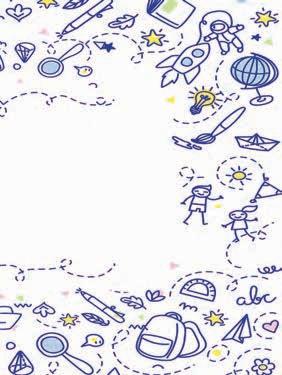



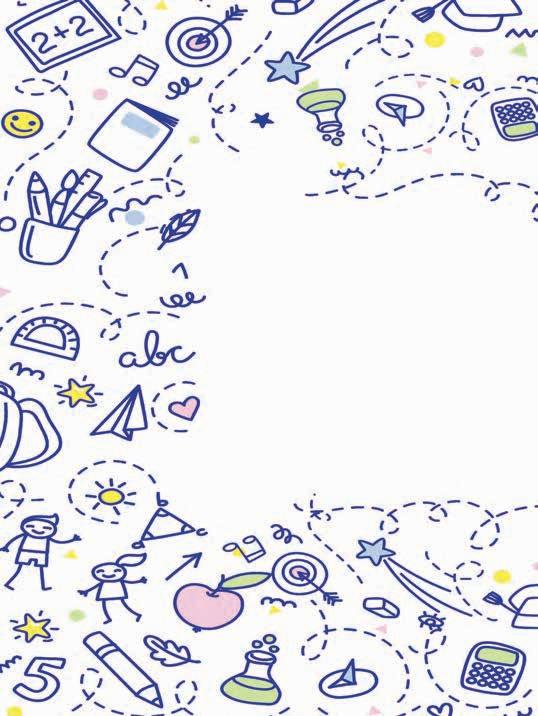
Describing
Describe common objects
Use simple words/phrases to describe the object’s colour, size, or shape
Use polite expressions in day-to-day interactions
Respond to polite expressions
Understand and follow simple action commands
Use simple action words to give clear instructions
Understand simple questions about oneself
Respond to basic questions about oneself using simple words/phrases
Understand simple questions about family and friends
Respond to basic questions about one’s family and friends using simple words/phrases
Understand simple questions about one’s daily routine
Respond to basic questions about one’s daily routine, using simple words/phrases
Understand simple questions during a conversation Respond to simple questions using a few words during a conversation
Make simple requests politely
Understand simple questions about one’s experiences Answer
questions about one’s experiences




Wake up, Tia! It’s school today.
Meet your friends—what will you say?
I’ll say hello and good morning too,
Then smile and ask, how are you?
wake up (wayk.up): to get up after sleep today (tu.day): this day meet (meet): to see someone face to face




If they say the same to me, I’ll say I’m fine, thank you! At the end, I’ll wave goodbye, With a big smile, not shy!

fine (fyn): good and healthy wave (wayv): to move your hand from side to side to say hello or goodbye. shy (shai): feeling quiet or not talking much
Talk Toolkit
Hello… Hello, friends!
Good morning… Good morning, teacher.
How are you… ? How are you, Grandma?
Goodbye… Goodbye, Dad!
Goodnight… Goodnight, Uncle. Sweet dreams.


Project 1A
Listen to Pihu greeting her brother. Then, record it.
Project 1B
Bye-Bye!
Viraaj says bye-bye to his friends. Listen to him and record it.
Project 1C
Kimaya meets her grandfather and greets him. Listen to her and record it.

/ay/ sound
These words end with the /ay/ sound.
Words with the same ending sound are called rhyming words. Find any TWO rhyming words in the poem and circle them.
Write ONE more word that ends with the /ay/ sound.







You are doing your homework. Your uncle arrives. How will you greet him?
Project 1D high five wave handshake hugs fist bump
Match the pictures with the greetings. One has been done for you.



You met your teacher in the playground. Greet them. Complete the dialogue. Then, practise and present it in the classroom.
Write: Fill in the blanks to complete the conversation.

, teacher.






Practise: At home, practise saying the greetings with an elder.
3
Present: Present your lines in the class.



Speak politely.
Smile when you speak. You can read from the book.



Write the greeting words that match the pictures. How well can I greet someone?


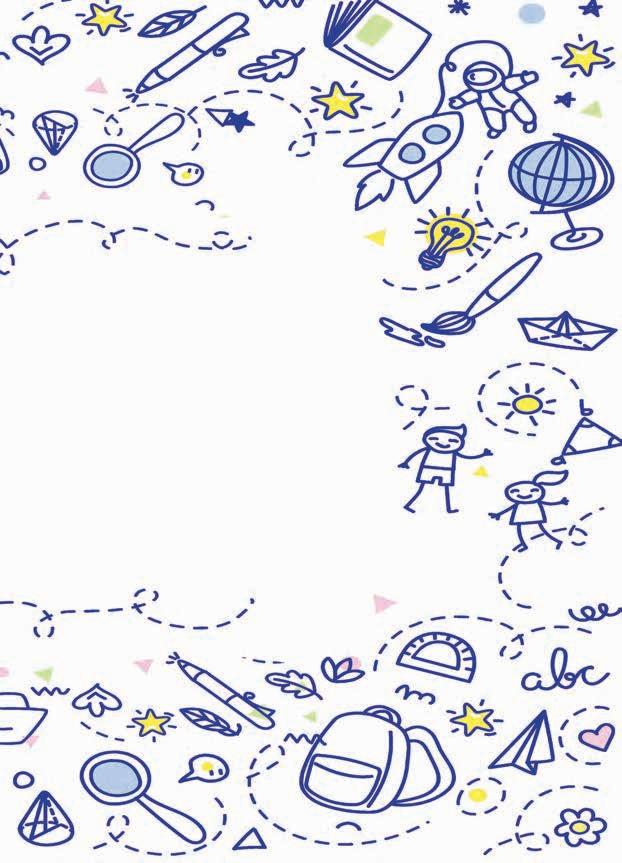


Wow, Dad! Is this red shiny bicycle for me?
Yes, it’s your birthday gift!



spill (spil): when water falls out by mistake leaks (leeks): when water comes out from a small hole

Describing Objects
/d/ sound

The letter ‘d’ is a consonant. The /d/ sound can come at the beginning, in the middle or at the end of a word. For example:
Find and circle TWO words with the /d/ sound in the text. Write ONE more word ending with the /d/ sound. BeginningMiddle End



Describing Objects



Describing Objects

Reflection Journal
4 new words I learnt:

One word to describe my things: pencil
school bag
lunchbox water bottle How well can I describe different objects?

Are you fine? May I help you up?
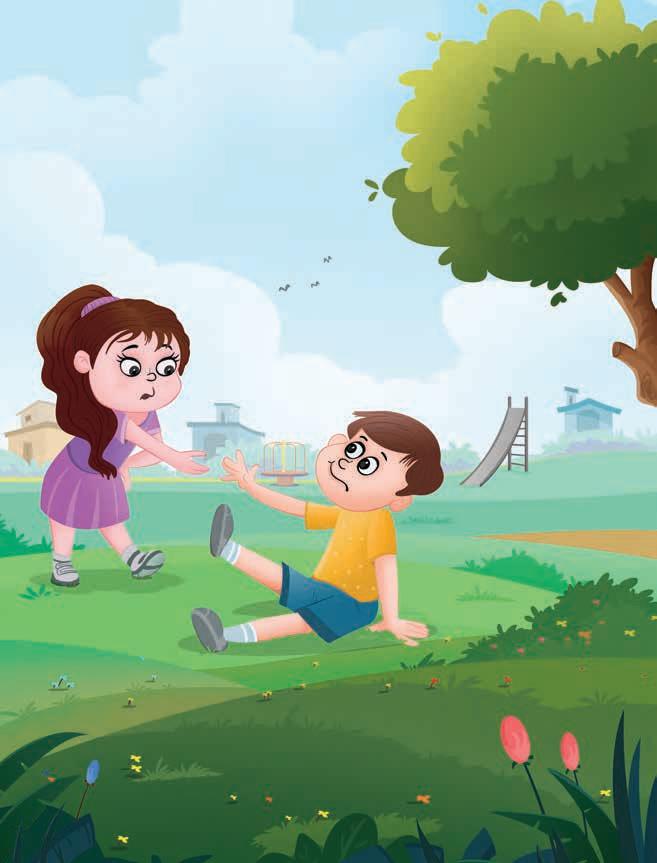
Thank you! I slipped, but I am fine.












I follow my teacher’s instructions when I do my homework.

Tap your left foot, tap, tap, tap.
Clap both hands, clap, clap, clap.
Shake your body, shake, shake, shake.
Raise your hands, wave, wave, wave.
Tap and clap and shake and wave.

shake (sheyk): to move from side to side or up and down raise (reyz): to lift something up




Tap and clap and shake and wave.
Hop like a bunny, hop, hop, hop.
Don’t move now, stop, stop, stop.
Sit on the floor, sit, sit, sit.
Quickly stand up, you are so fit!
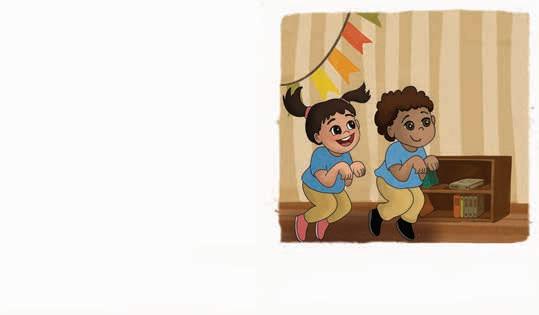
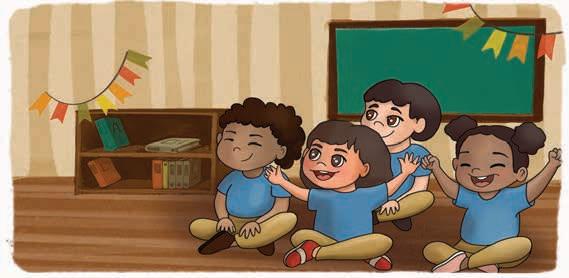
bunny (buh.nee): a rabbit quickly (kwik.lee): to do something fast fit (fit): to move quickly from side to side or up and down
Talk Toolkit
Write… Write your name. Read… Read this book.
Eat… Eat your food.
Play… Play with your ball.
Draw… Draw a cat.


Project 4A
Akshit tells what we should do to stay fit. Listen and record it.
Project 4B
Rohan is getting ready for school. He shares what to do. Listen and record it.
Project 4C
Arya is drawing a picture. She says what to do. Listen and record it.
Rhyming words have the same sound at the end. For example: clap and tap have the /ap/ sound at the end. They rhyme!
Here are some rhyming words: top and pop → /op/ sound kit and hit → /it/ sound
Find and circle ONE pair of rhyming words in the poem.
Now write any TWO rhyming words.



Listen to your teacher. Do what the teacher says.

Now come forward. Say any one action. Let your friends listen and do them.











Do the actions correctly. Speak loudly and clearly.



It’s a holiday. You want to tell your friends what they can do on a holiday. Think and say 1–2 lines.
It’s Fun Time
Match the actions with the words. One has been done for you.



Write the steps of an activity you do every day. Practise saying them at home. Then, tell your friends in class!
Write: Tick ( ü ) any ONE activity that you want to talk about. Fill in the correct sequence (1, 2, 3) in the given boxes for the activity you chose. Then, write the complete sentence in the space given below.


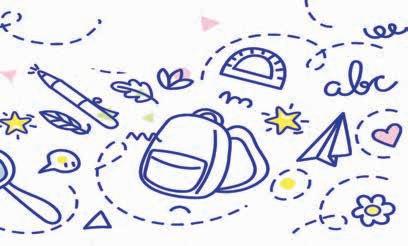


Hello!
Today I will talk about . Step 1: . Step 2: . Step 3: . Thank you.
2
3

Practise: At home, practise saying the steps a few times in front of your parents.
Present: In class, talk about the daily activity in front of your teacher and friends.



Speak loudly and clearly. You can read from the book. You can add more steps if you want to.







My name is Vihaan.
well (wel): feeling fine or healthy lovely (luh.vlee): pretty or beautiful
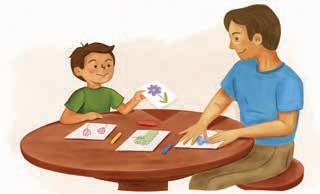




Vihaan: Yes, Uncle! I love drawing.
Adarsh uncle: Which class are you in?
Vihaan: I am in class 1C. My class teacher is Tanya ma’am.
Adarsh uncle: Wonderful! Which school do you go to?

Vihaan: I go to Peach Kids’ School. I love my school.
Adarsh uncle: I am so happy to hear that. Where is your papa?
Vihaan: He is in the kitchen. Come, let’s go.
wonderful (wuhn.duh.fl): very good or nice hear (heeuh): listen to kitchen (ki.chn): the place where we cook

Talk Toolkit
My name… My name is Riya. I am… I am six years old. I live… I live in Nagpur. I like... I like to dance.
My favourite… My favourite colour is red.


Project 5A
A boy tells his name. Listen and record it.
Project 5B
Riya talks about her favourite fruit. Listen and record it.
Project 5C
Kabir talks about where he lives. Listen and record it.
/l/ sound
These words begin with the /l/ sound.
Find and circle any TWO words beginning with the /l/ sound in the story.
Write ONE more word begnning with the /l/ sound.



Each one of us is special. Today, let’s talk about ourselves. Tick (ü) and share any TWO things about yourself.
Hello!
My name is … I am in class …
My birthday is on … (date)
The name of my teacher is …
The name of my school is … I live in …



Look at your friends when you speak. Speak clearly and with a smile.



We all love playing! Think and say 1–2 lines about what you like to play.
Tick ( ü) the activities you like to do.



1
Write: Your teacher will ask you some fun questions. Write your answers.



2
3
Which vegetable do you like?
Which animal do you like?
Which is your favourite toy? I like . I like . My favourite toy is .



Practise: Practise this with an elder at home.



Present: Present your lines in the class.

Look at your teacher when you answer. Speak politely. You can read your answers from the book.



4 new words I learnt:

Here are few things about me:
My name is . I am years old. I like .
How well can I talk about myself?

I need help.
I think I can do it.
I feel confident.




I love to spend time with my family.













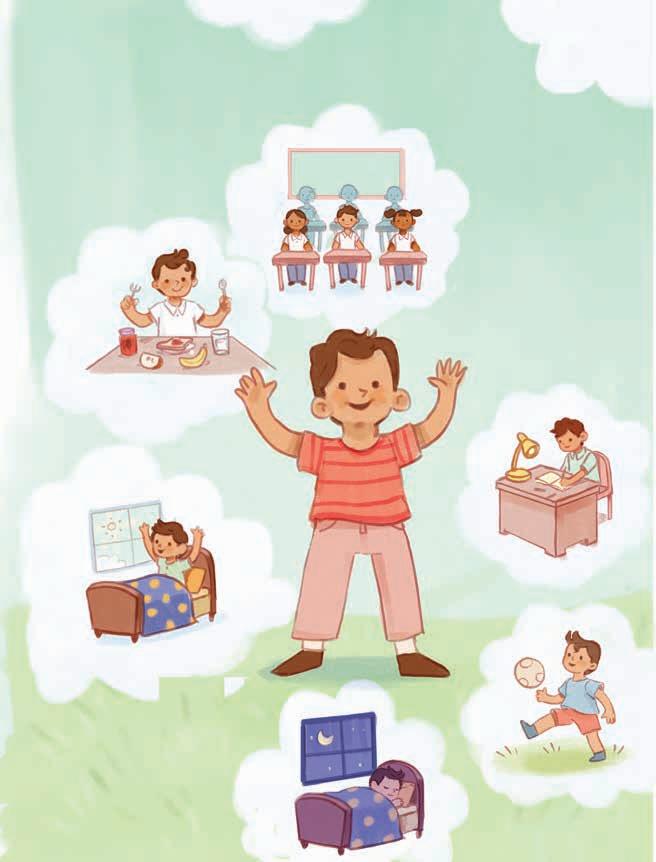
My daily routine—I wake up, eat, study, play, and sleep.
It’s time for school.
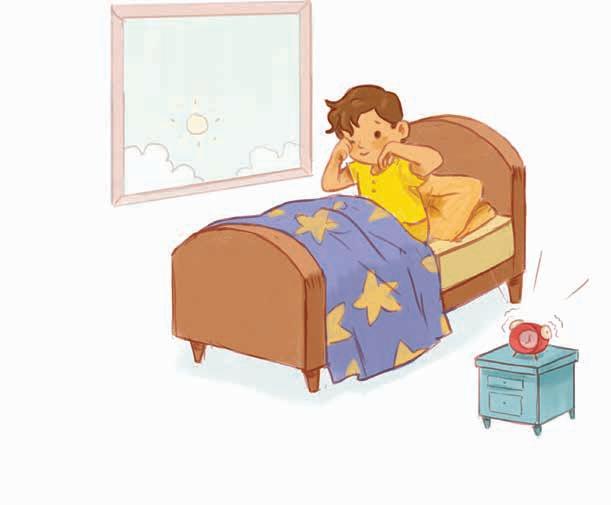
I wake up and brush my teeth. I take a bath and put on my school uniform. I comb my hair and eat my breakfast.

wake up (wayk.up): to get up after sleep put on (put on): to get dressed in clothes shoes, or a scarf breakfast (brek.fuhst): the first meal of the day that we eat in the morning



I put on my socks and shoes. I pack my bag and take my lunch box. I say goodbye to Mother and go to the bus stop.

pack (pak): to put things into a bag or box for carrying

Talk Toolkit
I… I eat my breakfast. I wear… I put on my school uniform. I go… I go to school. I do… I do my homework. I play… I play with my friends in the evening.


Project 7A
Tanu gets ready for school and tells us what she does. Listen and record it.
Project 7B
Vani goes for a morning walk with her grandfather. Listen to what she does and record it.

Project 7C
Krish loves listening to bedtime stories. Listen to him and record it.
We hear the short /o/ sound in many words. For example:
Find and circle any TWO words with the short /o/ sound in the story.
Write ONE new word that has the short /o/ sound in it.



Evenings are full of fun! Tick (ü) the correct option to show ONE thing you do in the evening. Then share it with the class.


Hi, in the evening I … .
do my homework play in the park read a book drink some milk play with my toys ride my bicycle





read a story help my mother
a picture

Look at your teacher while speaking. Listen to your friends when they share what they do in the evening.



We all go home after school. Share in 1–2 lines what you do after getting back from school.
It’s Fun Time
Look at the activities and number them in the correct order. One has been done for you.
Study at school
Wake up 1
Go to sleep
Have dinner with my family Go to school



Write about what you do on a Sunday morning. Complete the sentences using the correct words given in the box. Then, practise and share it with your friends in the class.
Write: Complete the sentences about what you do on a Sunday morning.
Hello friends!
Every Sunday, I wake up in the morning. Then, I and . After



Practise: Read the sentences aloud. Practise a few times at home. 2
Present: Now, say the sentences in the classroom. 3



You can also give your own answers. You can show the actions to make your presentation more fun!





Look at my glasses, aren’t they cool?
Yes, you look really smart in them!

One day, King Akbar called Birbal.
Akbar: Birbal, how are you?
Birbal: I am fine dear king. I hope you are doing well too.
Akbar: Yes, thank you. Can you do something for me?
Birbal: Sure, please tell me.
Akbar: Can you make me a painting?
Birbal: But my dear king, I cannot draw!
Akbar: You must try!
Birbal: Okay! I will try to complete the painting in two days!
painting (payn.ting): a picture made using colours



After two days…
Akbar: I only see blue, brown, and green spots! What is this, Birbal?
Birbal: Cows eating grass under the blue sky.
Akbar: Where are the cows? Where is the grass?
Birbal: The cows just ate the grass and left! King Akbar laughed and gave Birbal a big prize.
spots (spots): small marks or dots left (left): went away from a place prize (prize): something you win for doing well
Talk Toolkit
How are you… ?
I am…
Can you… ?

Hello Priya! How are you?
I am good. Thank you!
Can you help me, please? What… ? What do you like to do?
I like…
I like to play ludo. Where… ? Where do you live?



Project 8A
Let’s
Riya asks her brother, ‘Can we paint together?’ Listen to his reply and record it.
Project 8B
Let’s
Tanya meets Anjali after many days. Listen to what she says and record it.
Project 8C
Grandma asks Sanju, ‘Did you enjoy school today?’ Listen to his reply and record it.
The letter ‘p’ is a consonant. The /p/ sound can be heard in the beginning, middle, or end of words.
For example:

BeginningMiddle End
These words have the /p/ sound in them. Find and circle TWO words with the /p/ sound in the story. Write ONE more word with the /p/ sound in the beginning.



Your teacher is asking you about your favourite cartoon show. Answer the questions politely. Complete the sentence by ticking (ü) the correct option and share with the class.

Good morning, how are you? Good morning! … .

Which is your favourite cartoon? My favourite cartoon is … .

Who is your favourite character in the cartoon? My favourite character is … .

You can also act like your favourite cartoon!





Project 8D

Your friend asks, ‘What do you like to do in your holidays?’ Say in 1–2 lines and record it.
Look at the picture. Circle and tell Rohan where these things are.


Your teacher will ask you questions about your ride to school. Complete the sentences using the correct words from the box. Practise saying them at home. Then, answer the questions politely.
1
Write: Complete the sentences about your ride to school.










Who drops you at school? My drops me at school.
aunt brother sister driver father mother grandfather grandmother uncle

Practise: Practise your lines in front of your elders.
Present: Present your lines in the class. 3




Share one reason why you like coming to school.





Can I have one, please?

Sana is sad. Her favourite blue toy truck is broken. Suddenly, she hears a kind voice. It is an angel!
The angel says, ’You have three wishes.’
Sana asks politely, ’Can you please fix my truck?’
’Sure!’ says the angel. ’Here it is, good as new.’
Sana smiles and says, ‘Thank you!’
The angel asks, ’What is your next wish?’
angel (ayn.juhl): a kind person with magical powers fix (fiks): to make it work or repair it




Sana says, ’Can you please give us a cute puppy? We will play with it.’
’Yes, but promise me you will take care of it,’ says the angel.
’I will, I promise,’ says Sana.
’For my last wish,’ says Sana, ’I want my family to always be happy.’
The angel says, ’Your wishes will come true because you are polite and kind.’
Sana was filled with happiness and thanked the angel.
puppy (puh.pee): a baby dog
promise (pro.muhs): to say that you will do something for sure come true (kuhm troo): to make it real or happen
Talk Toolkit
May I… ?
Can I… ?

May I have some water, please?
Can I sit here, please? Please…
Please pass me the book. Kindly…
Kindly give me the book. Could you… ?
Could you help me, please?


Project 9A
Rohan tells his father about his toy. He wants his help. Listen and record it.
Project 9B
Arjun asks his friend to share his crayons. Listen to him and record it.
Project 9C
The Puppy
Tiya sees her puppy running around and asks her sister politely for help. Listen and record it.
Word families are words that have the same ending sound. For example: The -ill family
Find and circle ONE word from the story that belongs to the -ill family.
Write ONE new word that belongs to the –ill family.


Look at the pictures and choose any ONE situation. Then, tick (ü) the correct request for that situation and say it aloud.
• Will I go to the washroom?
• May I go to the washroom, please?
• Can I sit with you today?
• May you sit with me today?
• Can you find my class, please?
• May I enter the class, please?
• Can you find my bottle?
• May I drink some water, please?


Make requests with a smile on your face!



Imagine it is lunch break and you forgot your lunch box at home. How will you politely ask your friend for some food? Say it in 1–2 lines.
Tick (ü) the requests that you will make in a park.
Can I please ride your bicycle?
May I please play with you?
May I please borrow your pencil?
Can I play on the slide?
Could you please read me a story?
Can you please make my favourite dish?


You are at home and want to ask your mother to play a game with you. Complete the lines and present them to your teacher in the class.
1
Tick: Tick (ü) the board game you want to play.
















2
Write: Complete the dialogue between you and your mother. You may use the options given below.










3
May I Will I Please can start the game first? Yes! You can go first.
4


Practise: Read the lines aloud in front of an elder. Practise a few times with expression.
Present: Now, share your request with the class.




You can also talk about any other board game. Speak politely and with expression.
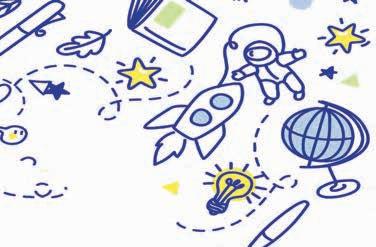
Tick (ü) the sentences that show a polite request:
May I play with the doll? Give me the bottle. Can you pass the ball, please? Write a polite request on your own. How well can I make a polite request?
May I play with the doll?
I want a cake. Give me the bottle. Give it to me. Can you pass the ball, please?
Kindly give me the pencil.

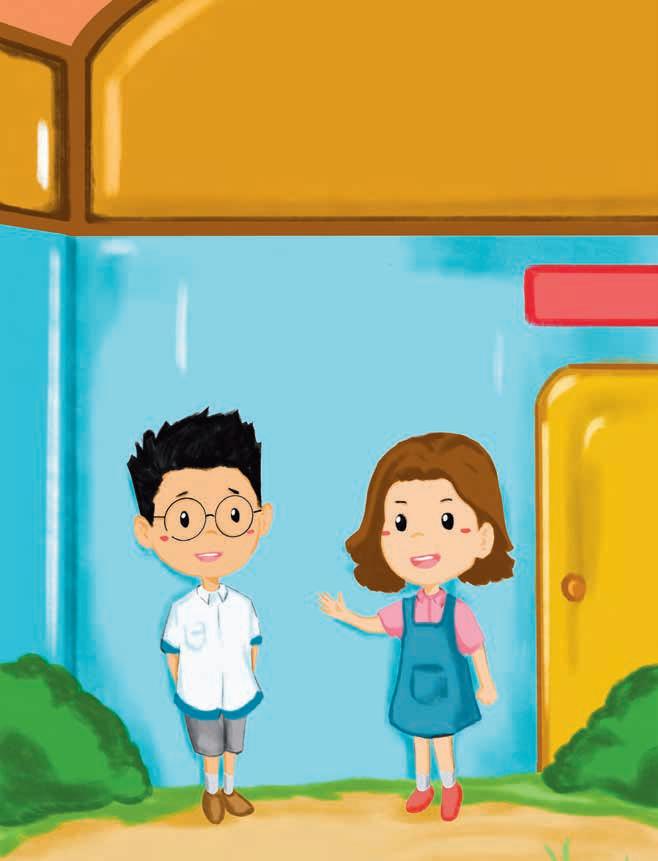
Excuse me! Where is the art room?

Jatin: Hi Avni! Good to see you.
Avni: Hi Jatin! Good to see you too.
Jatin: What should we play today?
Avni: Um… It is a breezy day today. So, how about flying kites?
Jatin: Of course! But where can we fly them from?
Avni: We can fly them from my terrace.
today (tu.day): on this day breezy day (breez.ee day): a day when the cool wind blows softly terrace (terr.uhs): a flat, open area at the top of a building or house



Jatin: Great! Let me go and get my butterfly-shaped kite. Which kite will you fly?
Avni: I will fly my dragon-shaped kite. It is a big and beautiful kite!
Jatin: This is going to be so much fun! Let us see who wins.
beautiful (byoo.tuh.fl): very pretty
Talk Toolkit
What… ?

What do you like to do?
Who… ? Who is your best friend?
Where… ? Where do you live?
When… ? When do you eat lunch?
Did… ? Did you bring my book?
Can… ? Can you help me?


Project 10A
Ayush wants to go out and play. He asks his father a question. Listen and record.
Project 10B
Rahul cannot find his eraser. He asks his mother about it. Listen and record what he says.
Project 10C
Priya comes home from school and asks her grandma what she is cooking. Listen and record.


Blends are two or more consonants that come together in a word. You can hear each sound in a blend.
Blends that come at the beginning of a word are called beginning blends.
For example: The word flag, begins with the blend ‘fl.’ Both the /f/ sound and the /l/ sound are pronounced. Say these words after your teacher. Find and circle ONE word beginning with the fl blend in the story. flip flower float



Work in pairs. Imagine you meet a new friend at the park. Ask your partner ONE question and listen to their answer. Then answer the question your partner asks you.






You can ask your own question or choose a question from the given list! But first, complete the question using the correct word.
Look at your partner when asking or answering the question.










Wait for your teacher’s response after asking a question.
Listen to your teacher’s answers carefully.

Reflection Journal



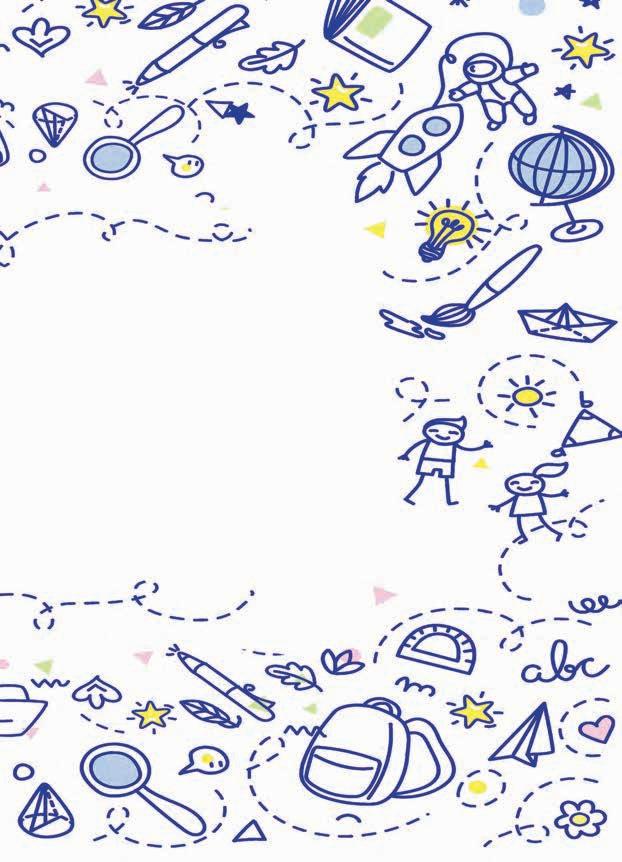
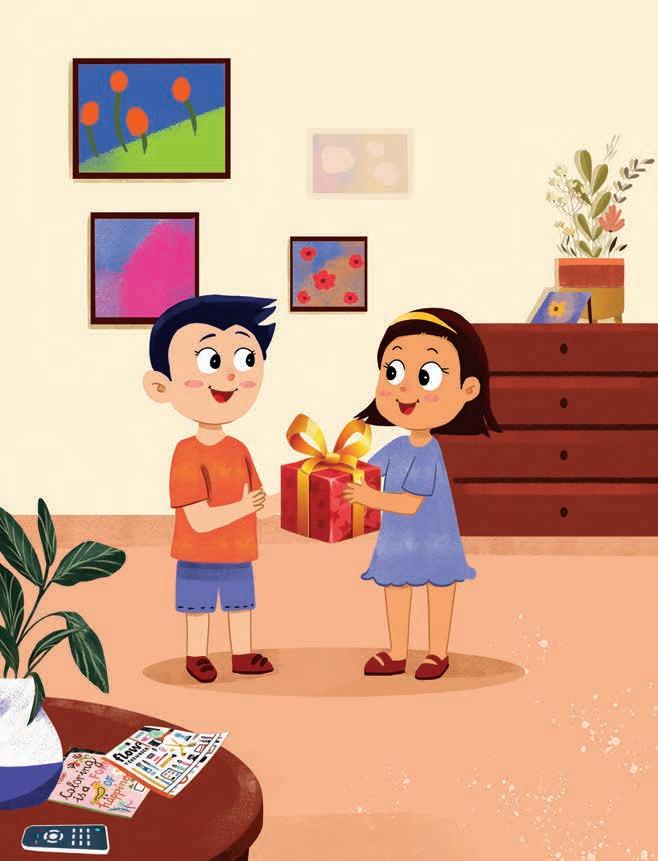
Congratulations on winning the first prize! I am so happy for you.














The puppy was running after me. I was so scared!





Blends are two or more consonants that come together in a word. You can hear each sound in blends.
Blends that come at the end of a word are called ending blends. For example: The word nest, ends with the blend ‘st.’ Both the /s/ sound and the /t/ sound are pronounced.
Say these words after your teacher ending with the st blend.
Find and circle ONE word ending with st blend in the story. fast list best last




Reflection Journal
Four new words I learnt:
Tick (ü) the things that you have done before:











Write ONE line about any one experience from the above. . How well can I share my experiences?



This SPEAK 2.0 book aims to systematically build English language skills in learners and enable them to verbally express themselves in real-world situations. Each chapter focusses on building specific English language competencies and weaves together activities that are research-based, age-appropriate, contextual, experiential and joyful. The activities adhere to the highly recommended and research-based teaching-learning method known as the Gradual Release of Responsibility (GRR), which has been endorsed by the NEP 2020 and the NCF 2022–23. Through the series, learners receive dedicated time and space within the classroom to express themselves in English which helps them in becoming confident speakers of the language.
• Activity-Based Learning: The book offers joyful experiential activities that build English communication competencies.
• Texts per the NEP 2020 Themes: The book has exciting and stimulating texts that pave the way for English communication activities.
• Tech Integration: The book works in sync with our digital component, where various other activities and projects are undertaken. Learner outputs are evaluated through an AI-based speech recognition engine.
• Teachers’ Manual: The book is complemented by the Teachers’ Manual that enables teachers to conduct each session effectively.
Uolo partners with K-12 schools to provide technology-enabled learning programs. We believe that pedagogy and technology must come together to deliver scalable learning experiences that generate measurable outcomes. Uolo is trusted by over 15,000+ schools across India, Southeast Asia and the Middle East.
ISBN 978-93-89057-21-8


